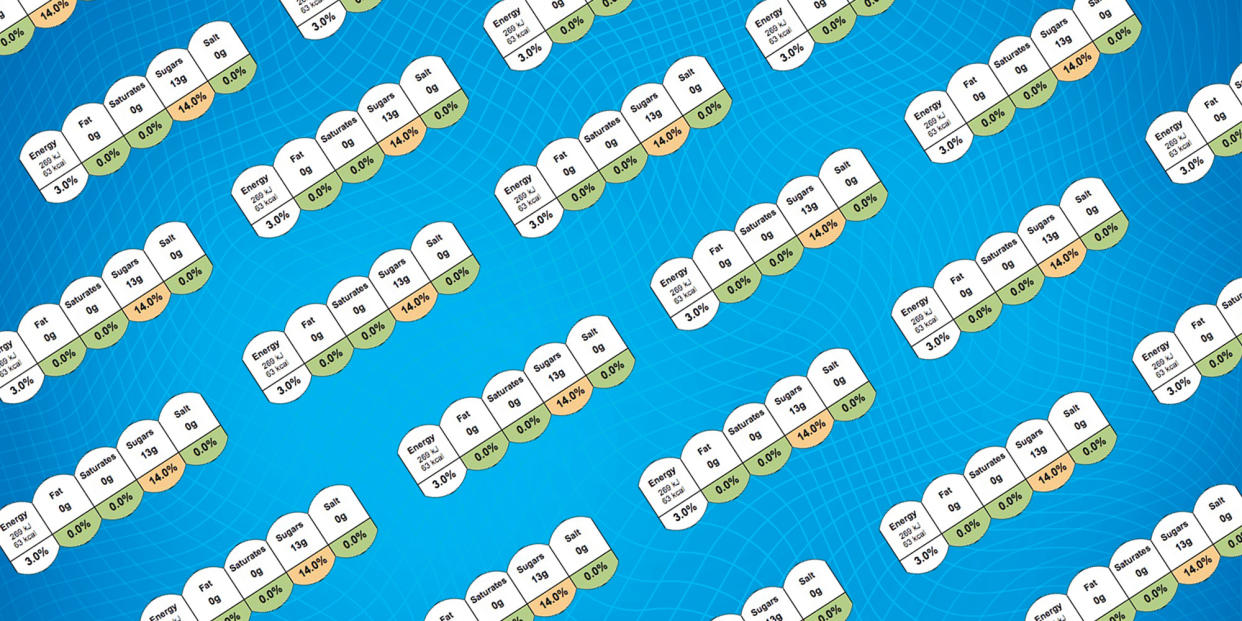Why nutrition labels should be read more carefully

In recent years, food packaging has started displaying its nutritional information a lot more clearly than it previously did, now using a traffic light system to indicate whether a product is particularly high in fat, sugar, salt and more. And it's proved really helpful in allowing shoppers to make a quick decision as to whether they want to purchase the product from a health perspective.
But one blogger, Lucy Mountain, has recently brought something to our attention via her Instagram account @thefffeed: brands' use of 'serving sizes' can often mean that consumers sometimes miss the full nutritional information on some foods.
On an average food product, you'll see the amount of sugar/salt/fat/whatever else listed in grams and also as a percentage of your recommended daily allowance. This is usually calculated per 100g, and per serving size. You will occasionally also see the nutritional information for the entire weight of the product, too, but not always.
And here's the thing: as Lucy points out with this particular Instagram post, sometimes a brand's idea of 'one serving' is not exactly in line with the consumer's.
Take this 125g pot of Coyo dairy free yoghurt: it's small in size, and would therefore usually be consumed by a person in one sitting. But if you look a bit closer at the yoghurt's nutritional information, as Lucy did, you'll spot that their idea of one serving size is only 80% of the pot. As Lucy puts it in her post: "'Sorry excuse me while I go put a spoonful of this yoghurt back in the fridge for another day.' - said no-one ever."
And she's right. Why on earth would you leave about two spoonfuls of yoghurt for a later date? You'd be much more likely eat the whole thing, yet the nutritional information displayed only takes into account a person eating 80% of the yoghurt. While the exact serving size is clarified on the pot, it's in fairly small print and is therefore easy to see how a shopper could miss this.
I looked around for other products which had similar 'serving sizes' when it comes to their nutritional information, and found this 300ml bottle of Tropicana as another example. A 300ml bottle contains less liquid than a standard can of soft drink, so it's safe to assume a person is fairly likely to drink the whole bottle in one sitting. Yet when you look at the nutritional information, as I did on Tesco's website, it only appears to break it down into either per '150ml serving' - half of the bottle's contents - or per 100ml.
It means that a quick glance at the traffic light system displayed below will only give you the information for half, or less, of what you're actually drinking.

Fitness blogger Lucy also made another important point in her Instagram post, and it's about how accurate the whole 'percentage of daily intake' thing is. These percentages, Lucy explains, "are a rough estimate based on the recommended guidelines set by the government. These are incredibly generalised.
"We come in all shapes and sizes; 2000 calories a day for a 5ft women who works behind a desk is likely to be too much. 2000 calories for a 6ft women who works as a dancer is likely to be too little," she adds. And it's a fair point. Don't assume that, just because a packet of Walkers crisps claims to take up just 7% of your daily salt intake, that that figure is actually accurate for you and your body.
So there's a clear lesson to be learned here for shoppers. Brands aren't actually doing anything technically wrong by opting to display their nutritional information according to serving sizes. Which means it's down to us as consumers to make sure we're paying closer attention to what we're reading, so we know exactly what we're eating.
Follow Cat on Instagram.
You Might Also Like


